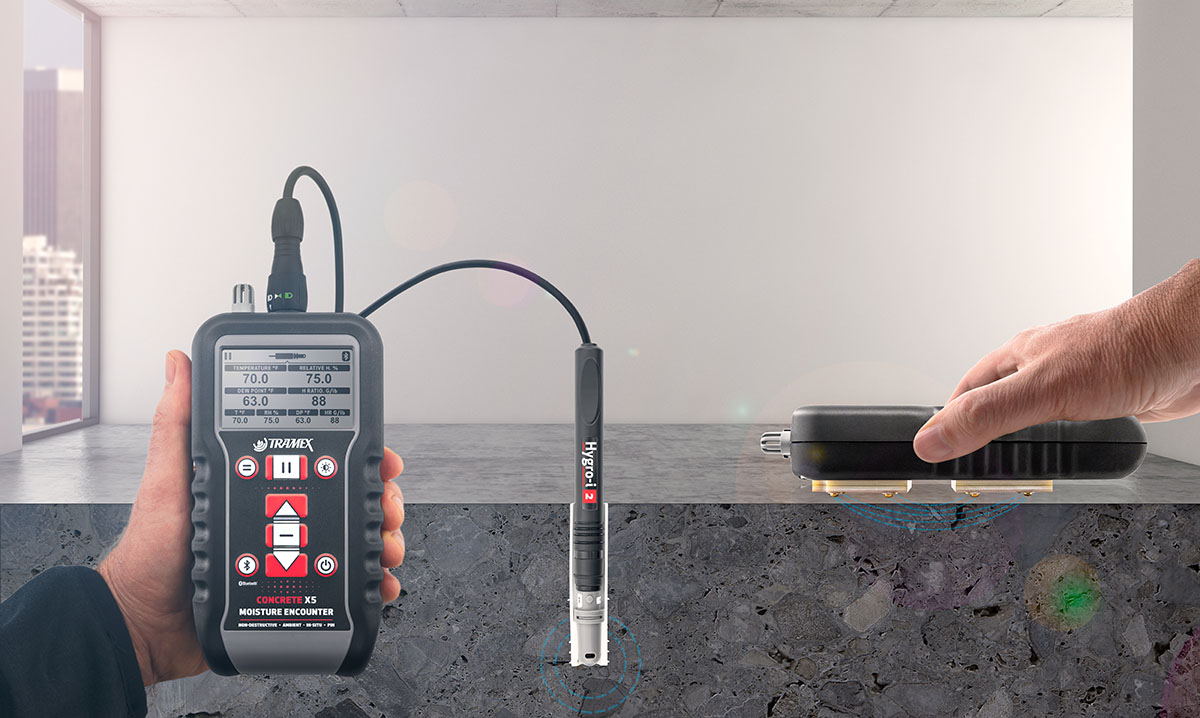
It generally takes about 24 to 48 for newly poured concrete to dry or harden enough to be able to walk on the surface. Cement is the binding ingredient in concrete. The concrete hardens as the cement particles, sand, and aggregate bind with the water in the concrete mix. The curing and drying process of concrete continues even after it has hardened and has been tested and deemed dry enough to receive a floor covering or coating, which can be below 4.5%, 4% or 3.5% depending on the moisture tolerance of the flooring coating or covering and manufacturer’s specifications.
For concrete and cementitious screeds to receive a floor covering we know that the base must be suitably “dry enough”. This is to prevent damage to the flooring material and to ensure a proper bond with adhesives. So, what is “dry enough”, how long does it take for concrete to reach this goal and what testing methods need to be carried out?
Moisture Content in Concrete
Water is a vital component in the manufacture of concrete and the concrete must be kept moist during the critical curing phase to ensure the intended concrete strength. During the curing phase, the process of Hydration chemically binds a large portion (approx. 50%) of the water with the cement paste which sets and hardens. What moisture is left after this reaction is either physically bound moisture that is trapped in the pores of the concrete, or what is known as Free Moisture.
This Free Moisture is what must be allowed to evaporate in order to reduce the moisture in the concrete to that acceptable level of “dry enough”. Although a the rule of thumb is to allow an inch per month (or mm per day), a number of factors such as slab depth will greatly influence the drying time. We will briefly look at these.
How to Moisture Test Concrete
The simplest and most fool-proof method of testing moisture in concrete and screeds is with a non-destructive, impedance type concrete moisture meter like the Tramex CME5 or CMEX5. These impedance type moisture meters provide quantitative measurements (as opposed to qualitative, 0-100 reference readings) and give a very quick and helpful indication of the overall moisture content of the concrete in percentage measurements of moisture content by weight, MC%.
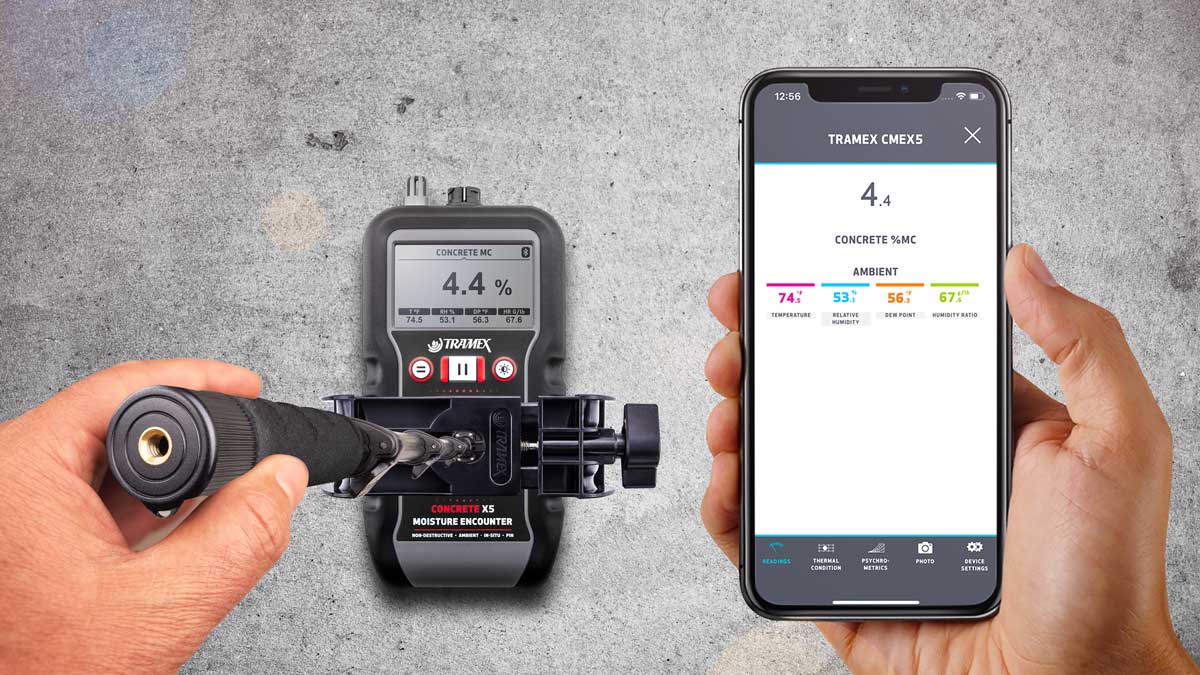
When is a concrete slab dry enough?
A common measurement specified by many manufacturers is ≤4% for products which are not designed to be moisture tolerant. Products which have a high moisture tolerance can be specified with readings as high as 6%. More and more flooring covering and adhesive manufacturers are specifying the readings with this measurement that suit their products. This makes life very easy for the flooring installer as the non-destructive concrete moisture test is extremely fast and has a low potential for user error.
How to perform the RH Hood test?
An insulated, impermeable box, the Tramex Hygrohood or the RH Hood, is affixed to a position on the surface of the slab which has been identified as the highest reading position (with an impedance meter preferably). The box is sealed with butyl tape to a clean, dust free surface and the airspace inside is allowed to equilibrate with the RH within the slab. Equilibration can take anything from 4 hours to 72 hours depending on the slab thickness.
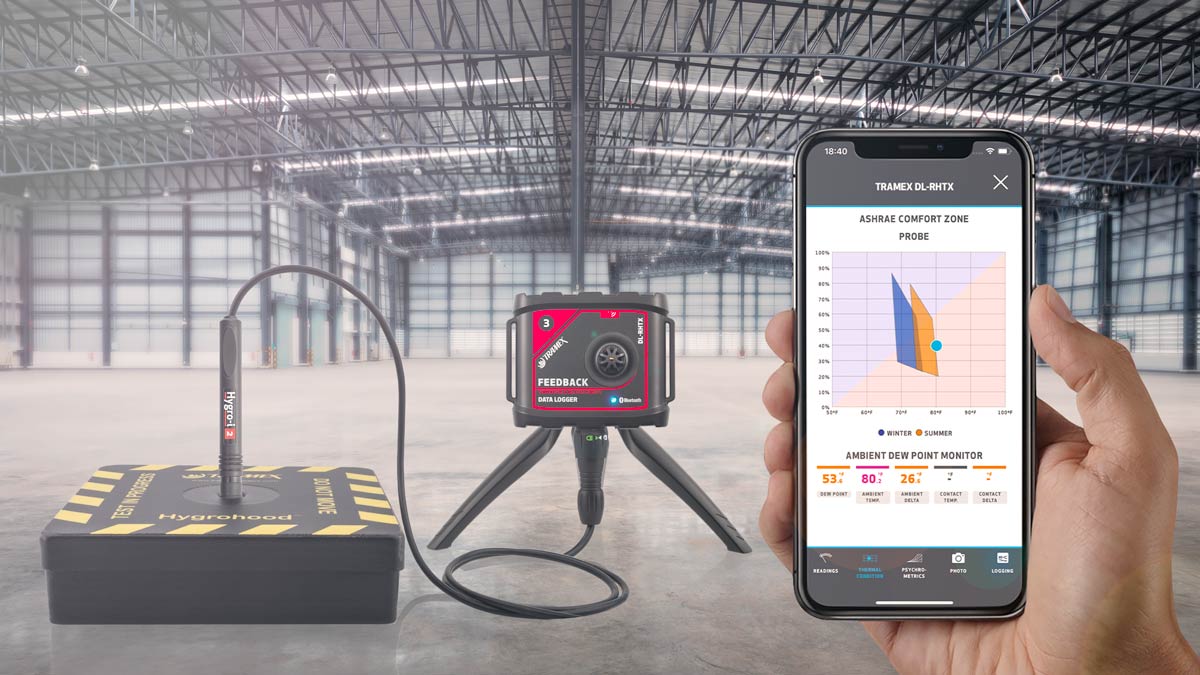
Once equilibrium is established a reading can be taken and compared to a second reading 4 hours later (or 24 hours later in the case of a 72 hour test) and, in most cases, a slab can be considered ‘dry enough’ when a reading of 75% or less is recorded with no change from the first measurement to the second, although floor covering manufacturers specifications should also be consulted. (For more detailed instruction see BS5325, BS8201 & BS8203).
The RH Hood test is useful in that it is non-destructive and fairly simple to perform, as long as the steps are followed correctly and the box is not disturbed during the equilibrium period. However, the potential for user error is high, in that the possibility of skewed readings due to temperature change can easily be missed by ignoring the British Standard advice for a follow-up test, 4 hours or 24 hours later as mentioned. A solution to this problem may be found by using a datalogging probe.
The British Standard Relative Humidity Hood test has been the most relied upon test method for many years and is specified by many UK manufacturers of flooring products.
The RH and concrete moisture content connection
Ambient RH can affect MC% readings. Temperature changes can cause large swings in RH test results and a high ambient RH of over 65% can result in condensation on the surface of the slab, causing higher MC% readings.
A commonly asked question is how the RH Hood method and the Moisture Content method correlate and this is a useful point to note: In a laboratory situation where temperature and humidity are constant at say 80%RH & 20ºC, a sample of average quality concrete will eventually equalize at approx. 4% MC. In the field, however, conditions are usually anything but stable and so temperature changes can cause large swings in RH test results and a high ambient RH of over 65% can result in condensation on the surface of the slab, causing higher MC% readings. However, other factors also affect the correlation between RH% and MC%, especially the water-cement (w/c) ratio.
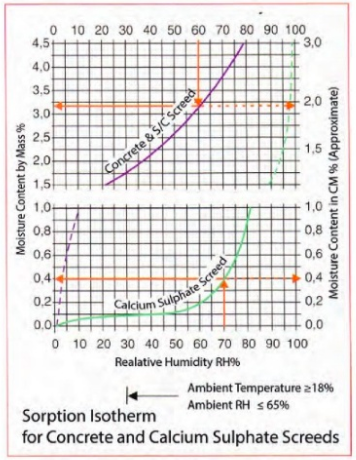 Figure 1
Figure 1
A sorption Isotherm chart such as the one in Figure 1, provides a helpful indication of the measurements that should be expected so that when readings are far apart from each other and do not correlate as expected, it can be a good indication that one reading could be very wrong and that further investigation is needed. As such, we can see that performing two different tests is worth much more than the sum of their parts.
The In Situ RH test for concrete slabs
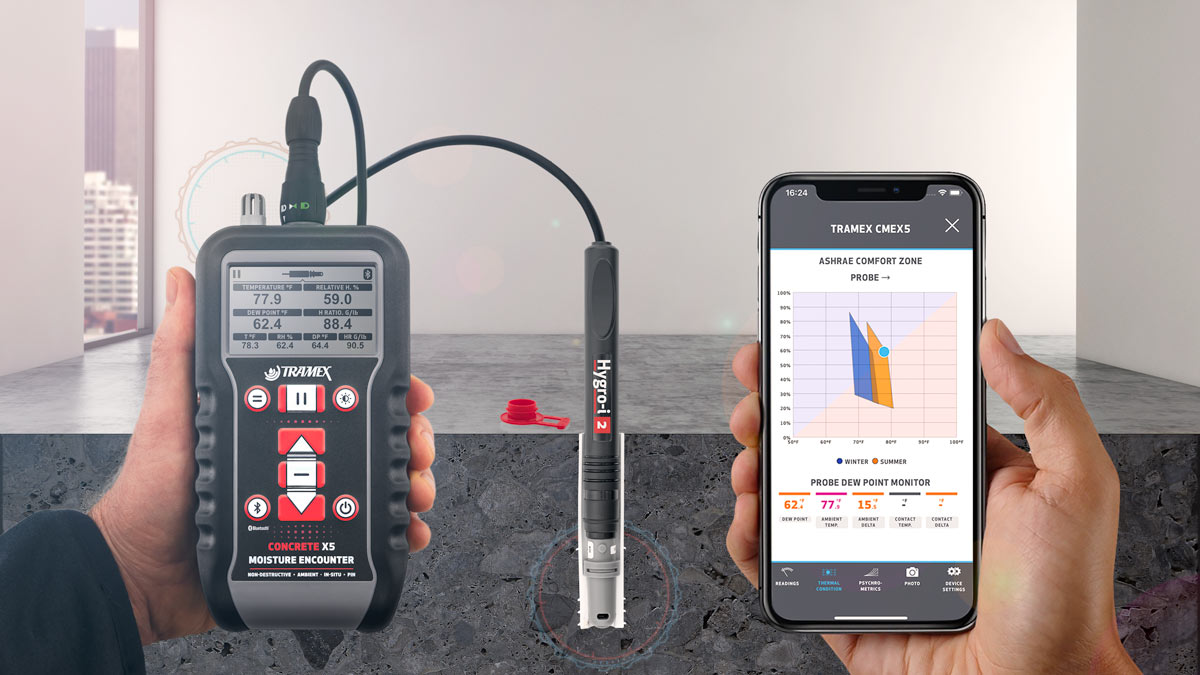
This in-situ RH test method is similar to the RH Hood method in that a trapped airspace is allowed to equilibrate with the RH within the slab. This test is destructive, however, involving drilling a hole into the slab to a specified depth of the total thickness, placing a plastic tube (or sleeve) into the cleaned hole and sealing with a plastic cap. Once equilibrium is established a hygrometer probe, like the Tramex Hygro-i2® is placed into the sleeve and given 30 minutes to acclimate before taking a reading with the CMEX5. Tramex has developed several concrete moisture test kits and flooring inspection kits containing all the necessary tools and instruments to perform this test such as the Flooring Inspector EZ Kit, the Flooring Inspector Kit or the more extensive Flooring Master Kit.
It is vital, to ensure a proper reading, that the probe is not placed in the hole too early as the heat from the drill will disturb the equilibrium. The benefit of the RH Sleeve method is that the entrapped airspace is much smaller and therefore equilibrium is established much faster than is possible with the RH Hood method. If following probe manufacturers’ instructions, the test can be performed in a shorter period of 24 hours or less in some cases.
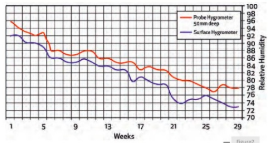 Figure 2
Figure 2
However, the complication with this test method is sometimes in regard to confusion over the drying goal reading values required. It has been shown that readings taken with the RH Sleeve method can be higher than the RH Hood method, commonly by between 5%-10%. Floor covering manufacturers who specify the in-depth sleeve method will often specify an upper limit of 85% instead of the 75% associated with the RH Hood. See Figure 2.
Concrete drying time
Having established our “drying goals” and ‘what is dry enough?’, we can now turn back to estimated drying times and the question of ‘how long?’. In concrete construction a large amount of water is initially used in the mix, often ca. 180 litres per cubic meter. This amounts to approx. 10-14% of the total weight of the material, depending on the water-cement (w/c) ratio. As discussed, approx. 50% of this water becomes chemically bound in the curing phase.
The w/c ratio is an important factor affecting the drying time of concrete. The lower the w/c ratio (i.e. less water & more cement) the finer the pores in the pore structure, which in turn reduces the transport velocity of moisture in the concrete and therefore produces a slower rate of drying. However, the lower water content of course also reduces the amount of water that has to evaporate, which should result in an overall shorter drying time. These and other factors are illustrated in the following charts which are interpreted from testing produced by the Swedish Concrete Association.
All drying times listed below are to reach a drying goal of 4%MC (Impedance Method), 75%RH (RH Hood Method), and 85%RH (In-depth RH Sleeve Method).
Concrete drying time chart
Drying time for upper floor, above-grade slabs (drying from both sides) with different thickness and w/c ratios (Days) in normal drying conditions: 60%RH & 18ºC (Swedish concrete association 1997):
|
Thickness (mm) |
w/c = 0.4 |
w/c = 0.5 |
w/c = 0.6 |
w/c = 0.7 |
|
100 |
20 days |
36 days |
54 days |
72 days |
|
150 |
40 days |
72 days |
108 days |
126 days |
|
180 |
50 days |
90 days |
135 days |
180 days |
|
200 |
55 days |
99 days |
149 days |
216 days |
|
250 |
65 days |
126 days |
203 days |
324 days |
Drying time for on-grade slabs (drying from one side only) with different thickness and w/c ratios (Days) in normal drying conditions: 60%RH & 18ºC (Swedish concrete association 1997):
|
Thickness (mm) |
w/c = 0.4 |
w/c = 0.5 |
w/c = 0.6 |
w/c = 0.7 |
|
100 |
40 days |
83 days |
140 days |
230 days |
|
150 |
80 days |
165 days |
280 days |
403 days |
|
180 |
100 days |
208 days |
351 days |
576 days |
|
200 |
110 days |
228 days |
388 days |
691 days |
|
250 |
130 days |
290 days |
528 days |
1035 days |
Taking into account different site conditions in the form of ambient temperature and RH allows for a greater level of accuracy in prediction. The following table shows correction factors which can be applied to the drying times above as simple multipliers (Swedish concrete association 1997):
|
RH% |
10ºC |
18ºC |
25ºC |
30ºC |
|
35% |
1.2 |
0.8 |
0.7 |
0.6 |
|
50% |
1.2 |
0.9 |
0.7 |
0.6 |
|
60% |
1.3 |
1.0 |
0.8 |
0.7 |
|
70% |
1.4 |
1.1 |
0.8 |
0.7 |
|
80% |
1.7 |
1.2 |
1.0 |
0.9 |
An example to illustrate would be:
A 180mm below-grade slab drying from one side only with a w/c = 0.6, adjusted for 30ºC & 35%RH = 211 days. (i.e. 351 x 0.6 = 210.6)
These corrections show how much ambient site conditions can improve or impair the drying time of concrete and how important it is to monitor these conditions for the duration of the drying phase. This can easily be done with a datalogger, the Tramex DL-RHTA or DL-RHTX which can be very helpful to the flooring installer so as to influence the contractor in understanding the importance of managing site conditions properly.
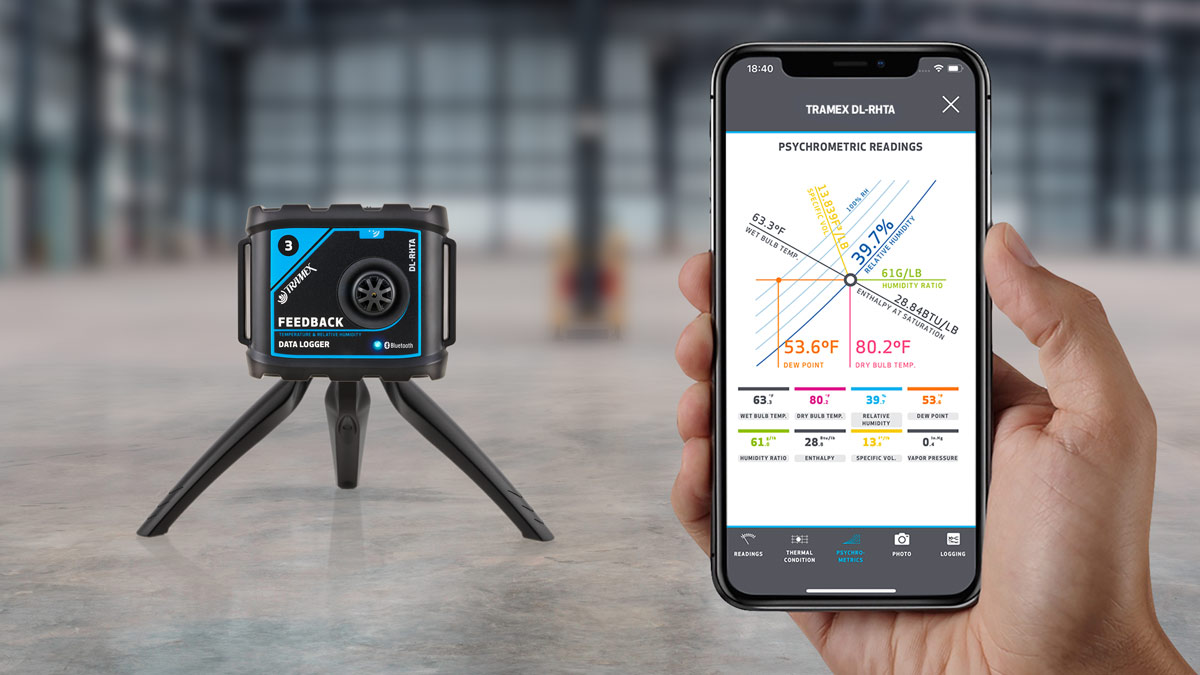
Managing site conditions may not require much. On warm summer days, this can be simply ensuring windows and doors are open to allow good airflow, while in other times of the year this normally involves de-humidifiers and air-movers as well as artificial heating aids.
Managing and monitoring slab and site conditions will help establish how long it may take to dry the slab. Performing the prescribed moisture tests will then help establish when the slab is “dry enough”.
By Kelvin Rynhart, Tramex Meters, Managing Director